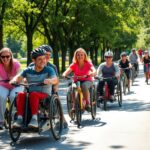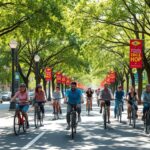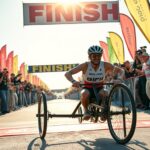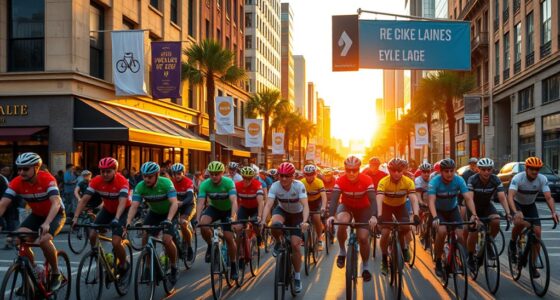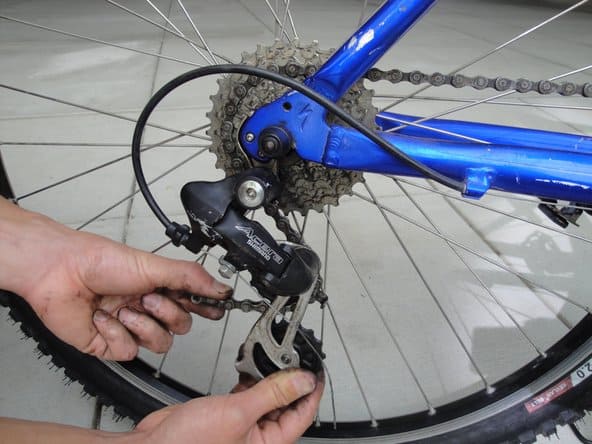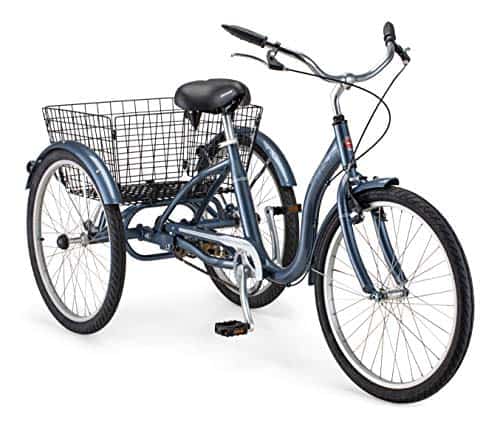Community programs that promote cycling for people with disabilities emphasize adaptive equipment like handcycles and modified bikes, making riding accessible and comfortable. They focus on skill-building through tailored training and inclusive events, while engaging local organizations and community champions to increase outreach. Funding options include grants and partnerships, ensuring resources for adaptive gear. Successful programs track health and participation outcomes, continually refining their approaches. To discover more about creating or participating in such impactful initiatives, keep exploring how these efforts come together.
Key Takeaways
- Community programs often include adaptive cycling equipment and specialized training to ensure inclusive access for people with disabilities.
- Initiatives like All Kids Bike Inclusive Learn-to-Ride promote skill development through tailored instruction and adaptive methods.
- Community rides, events, and outreach foster social inclusion, trust, and engagement among diverse participants with disabilities.
- Partnerships with local organizations and inclusive marketing increase awareness and participation in adaptive cycling programs.
- Funding strategies, including grants and community fundraising, support adaptive equipment acquisition and program sustainability.
Adaptive Cycling Initiatives and Equipment Accessibility
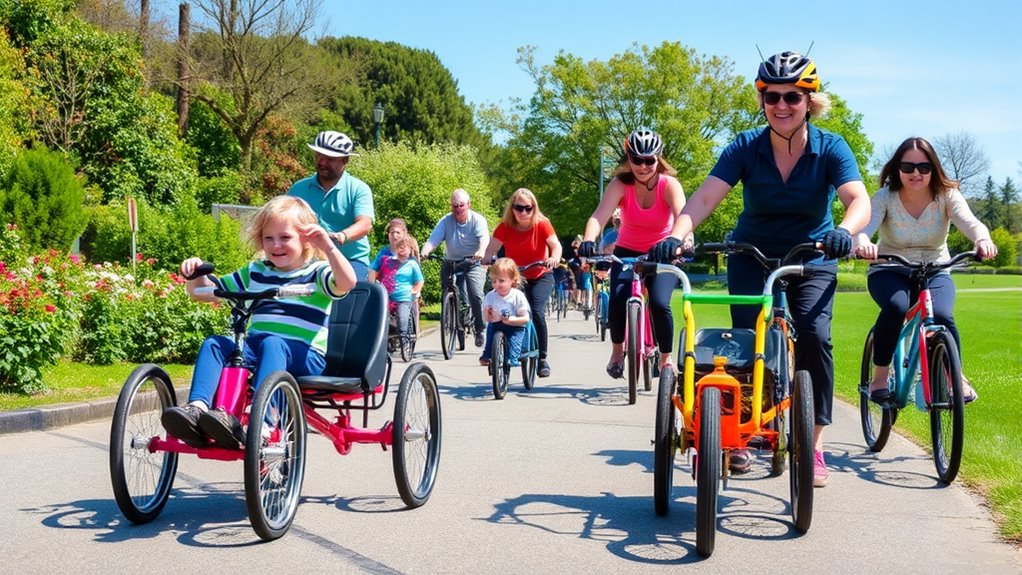
Adaptive cycling initiatives have markedly improved equipment accessibility for people with disabilities by offering a diverse range of specialized bikes. You can choose from handcycles that attach directly to wheelchairs, making transfers unnecessary, or modified standard bikes outfitted with stabilizers, ergonomic seats, and pedal assist systems for easier riding. Incorporating multi-functional equipment designed for different needs ensures a broader inclusion of riders with varying abilities. These modifications often include features to support individual mobility limitations and enhance comfort during rides. Three-wheeled trikes provide stability and adjustable features to suit different mobility needs, while tandem bicycles enable visually impaired riders to cycle with a partner. Electric assist models help reduce physical effort, making long rides more manageable. Additionally, the development of adaptive cycling technology continues to expand possibilities for riders with diverse needs, ensuring more inclusive access to cycling activities. Innovations such as adaptive control systems are also enhancing the ease of operation for riders with limited dexterity. Furthermore, ongoing innovations in accessible design are crucial for creating inclusive environments that accommodate a wider range of disabilities.
Community programs also promote access through equipment loan systems, organized group rides, inclusive events, and trail development designed with adaptive users in mind. These initiatives guarantee that more people can enjoy cycling comfortably and safely.
Skill Development and Training Programs
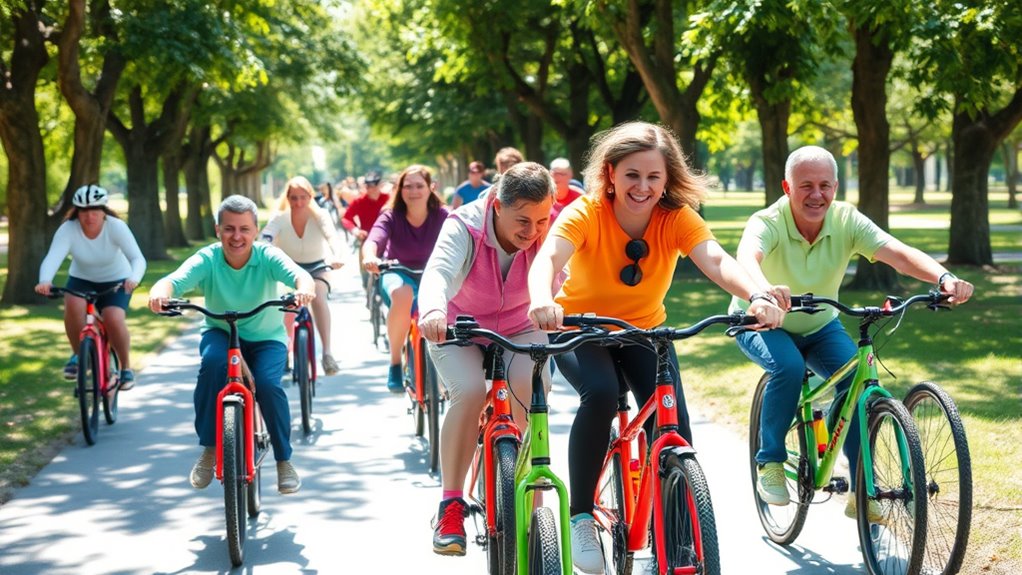
Skill development and training programs are essential for helping people with disabilities learn to ride confidently and safely. You can participate in programs like the All Kids Bike Inclusive Learn-to-Ride, which uses balance bikes to build foundational skills, or the Wounded Warrior Project Cycling Program, focusing on cycling techniques for warriors. Online resources from the CHAIN Program support practitioners in teaching young people, while adaptive training methods tailor approaches to individual needs. Techniques such as balance bike training, pedal conversion kits, and step-by-step learning foster gradual skill development. Instructor training ensures supportive instruction, and interactive resources enhance learning. Staying informed about Legislative changes can help ensure these programs are adequately funded and accessible. These programs promote inclusion, improve mobility, and boost confidence, enabling participants to enjoy cycling’s physical and psychological benefits while connecting with their communities. Additionally, retail hours for cycling gear and accessories can be helpful for participants seeking equipment, as many stores now offer extended hours and online shopping options. Necessary cookies are used to ensure the proper functioning of the website, helping deliver a seamless experience for users.
Community Engagement and Outreach Efforts

Engaging communities is essential to expanding participation in cycling programs for people with disabilities. You can do this by highlighting diverse groups in community rides, making cycling more relatable and inviting. Utilizing self-watering techniques as an analogy, ensuring consistent support and resources helps sustain engagement over time. Partnering with local organizations like bike clubs or community centers boosts outreach and encourages involvement. Using inclusive marketing—showing people with disabilities in promotional materials—helps normalize participation. Organizing accessible community events and rides builds trust and fosters engagement. Establishing feedback channels allows participants to share ideas and improve programs. To reach hard-to-access communities, focus on building trust through consistent service and community involvement. Tailoring outreach efforts to address specific barriers and understanding market sentiment can enhance effectiveness. Incorporating cultural intelligence into outreach strategies ensures messaging resonates across diverse communities, fostering greater inclusivity. Collaborating with disability advocacy groups, and using accessible communication methods, can further improve outreach efforts. Community ambassadors from diverse backgrounds can further promote cycling and increase participation. Recognizing the importance of ear wax odor can also serve as a metaphor for understanding individual needs and sensitivities within the community. Additionally, applying website performance metrics enables organizers to analyze engagement patterns and optimize outreach initiatives.
Funding Strategies and Resource Support
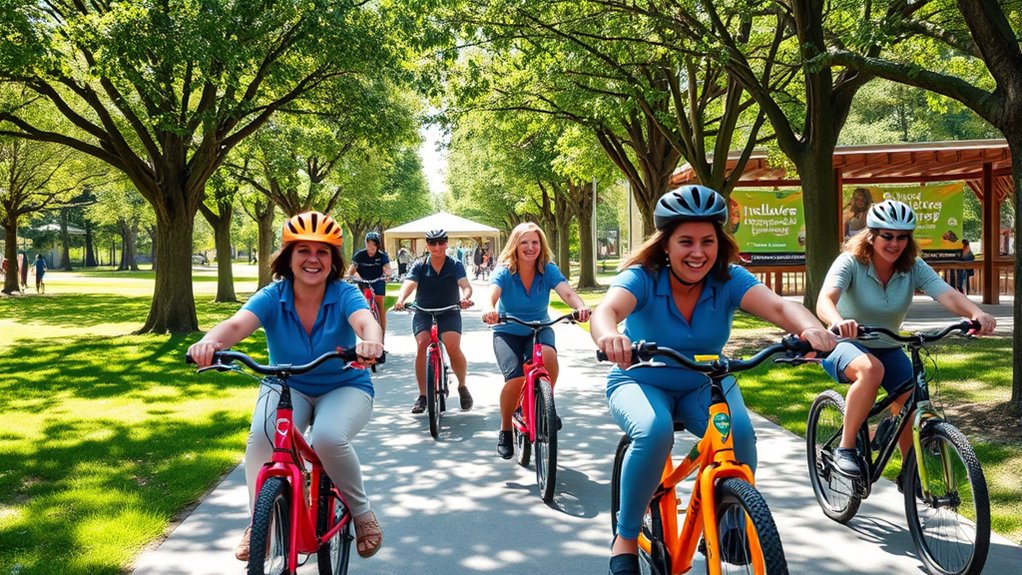
Securing funding and resources is essential for expanding community cycling programs for people with disabilities. You’ll need to navigate a complex landscape of insurance policies, government grants, and nonprofit partnerships. Medical justifications are often required to approve adaptive equipment, with higher-tier insurance plans more likely to cover costs. Incorporating cultural narratives through programs can also foster greater community engagement and support for inclusive cycling initiatives. Additionally, understanding emerging sneaker trends and how they influence athletic gear can help in selecting appropriate equipment and apparel for participants. Recognizing the horsepower of electric bikes can aid in demonstrating the performance capabilities necessary for adaptive cycling devices. Organizations like Freedom Concepts and Help Hope Live help you find pathways for funding through advocacy, documentation, and community fundraising. Being aware of the nutritional value of various foods can support holistic health programs for participants, emphasizing the importance of nutrition in overall wellness. Exploring exfoliation benefits with products containing glycolic acid can also contribute to the overall health and comfort of participants by promoting healthier skin. Grant programs such as USA Cycling’s Community Impact Grant and Bicycle Friendly America’s Community Spark Grants offer financial support, often with specific application windows. Corporate partners like General Motors and Achilles International also provide funding and collaborative opportunities. Early preparation of medical documentation and strategic planning are key to maximizing your chances of securing partial or full funding for adaptive cycling resources.
Measuring Impact and Success Metrics
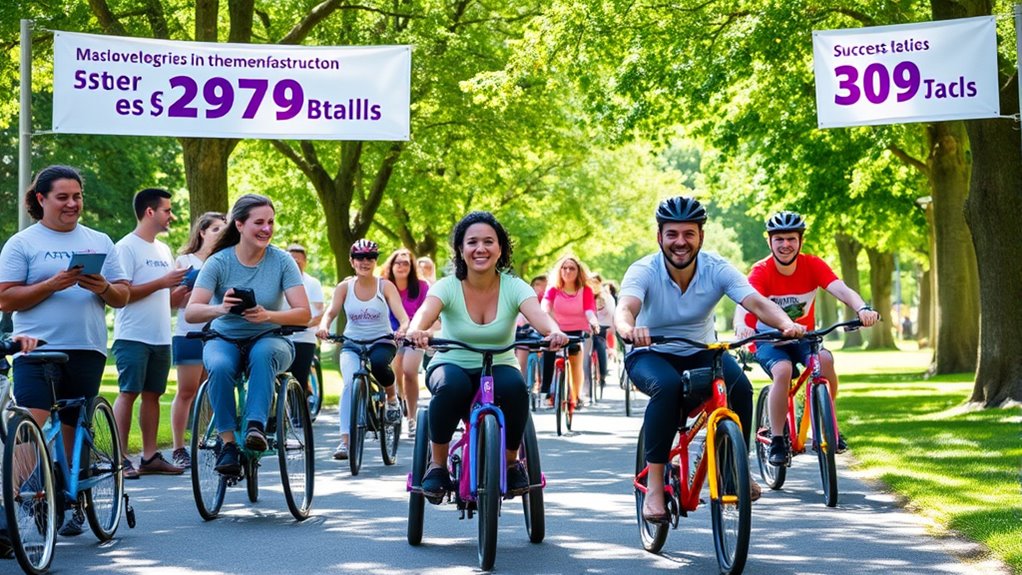
To demonstrate the value and effectiveness of community cycling programs for people with disabilities, you need clear methods for measuring impact and success. You should track physical health improvements, such as enhanced gross motor function, increased muscle strength, better cardiovascular fitness, and improved balance. Utilizing data-driven strategies can help in establishing measurable outcomes and refining program approaches. Measuring reductions in sedentary behavior can also indicate success. Additionally, assess mental health benefits like stress reduction, increased self-confidence, and positive emotional experiences. Social inclusion is crucial; monitor community engagement, family participation, and peer interaction. Use participant feedback, standardized assessments, and longitudinal studies to gauge outcomes. Incorporating adaptive equipment and customizing it to individual needs are essential for accurate measurement. Recognizing research gaps, such as the need for long-term data and validated metrics, will help refine evaluation methods and demonstrate program impact effectively. Moreover, understanding the role of spiritual energy and its influence on overall well-being can also offer valuable insights into holistic health outcomes for participants. Emphasizing holistic health approaches can further enhance program success and participant satisfaction.
Frequently Asked Questions
How Do Programs Customize Bicycles for Different Disabilities?
You might wonder how bikes are customized for different disabilities. Organizations assess each rider’s unique needs, then modify bikes with features like supportive seats, headrests, or footplates for stability.
For balance issues, they use tricycles or recumbent styles, and for significant disabilities, they adapt handlebars and seating. Sensory considerations and adjustable components guarantee comfort and safety.
This tailored approach helps you enjoy cycling, boosting your independence and confidence.
What Safety Measures Are in Place During Adaptive Cycling Sessions?
Did you know that adaptive cycling programs report a 95% safety compliance rate? During sessions, you’re protected with adjustable components, high-visibility gear, and customized instruction.
Trained staff provide hands-on assistance and monitor your equipment, while environmental modifications, like traffic-free zones and smooth surfaces, minimize risks.
You also learn auditory awareness and communication skills, ensuring you stay safe, confident, and enjoy your ride while reducing accident chances considerably.
How Can Volunteers Get Involved in Community Cycling Initiatives?
You can get involved in community cycling initiatives by volunteering in various roles like bike maintenance, helping with bike fittings, or riding as a buddy to support participants.
Attend training sessions to learn about adaptive equipment and safety procedures.
Promote programs through social media or at community events.
Your participation helps increase mobility, confidence, and inclusivity, making cycling accessible and enjoyable for everyone while fostering a stronger, more connected community.
Are There Eligibility Requirements for Participating in These Programs?
You might wonder if there are eligibility requirements to join these programs. Yes, you’ll need to meet specific criteria like age limits, which vary by program, and provide documentation of your disability from a licensed healthcare professional.
Additionally, some programs require you to live within certain areas and complete an application process. These steps make sure you get the right support and that resources are allocated effectively to those who qualify.
How Is Participant Progress Tracked Over Time?
You track participant progress over time by using multiple methods. Standardized surveys help you measure changes in participation and perceived barriers. Video analysis and wearable sensors monitor technical skills and physiological responses. Participation logs record attendance and equipment use.
You set goals with SMART criteria, then review skill progression charts and feedback apps regularly. By combining these tools, you get a thorough view of each individual’s improvements, challenges, and overall engagement.
Conclusion
By supporting these programs, you’re opening a world where barriers crumble and every person with a disability can soar on two wheels. Imagine a community where wheels turn freely, spirits soar higher than mountains, and every pedal stroke sparks a revolution of inclusion. Your involvement transforms lives into unstoppable journeys of freedom and joy. Together, we’re not just promoting cycling—we’re releasing unstoppable waves of hope that will ripple through generations to come.


